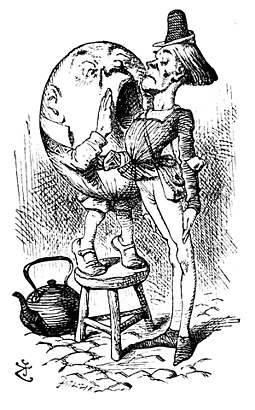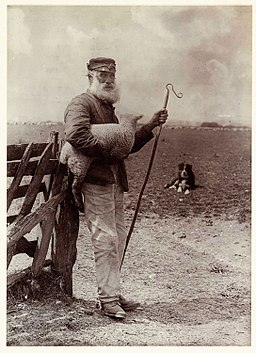Let’s Be Clear
There is only one rule of grammar, and that is “Be Clear”. All the rest of what people think are hard and fast rules of grammar are really only guidelines in the service of the supreme rule, “Be Clear”. Placing a comma or period outside of quotation marks may violate the guideline for American usage (though not necessarily British usage), but if doing so serves logic, and therefore clarity, then there’s nothing wrong with the practice. If you’re writing a diary purely for your own eyes, then by all means write however you please. If you’re writing to be understood by other human beings, however, then it’s simple courtesy to convey your message to them clearly.

“I said it very loud and clear: I went and shouted in his ear.” Humpty Dumpty recites from his poem in Lewis Carroll’s Through the Looking-Glass, and What Alice Found There. Illustration by John Tenniel.
Stop confusing “complement” with “compliment”, “affect” with “effect”, and “their” with “they’re”. There are many other examples of writers being lazy about the meanings of the words they use. Ignorance is not an excuse, not when a print dictionary can be had for a few dollars, and an online dictionary is usually free. A complimentary breakfast is free; a complementary breakfast is something else entirely, if it exists at all. Readers are affected by the effects of a writer’s word choices. They’re struggling to make sense of a lazy writer’s meanderings, and their poor understanding is all the fault of the lazy writer.
From the 1972 “Password” episode of the television series The Odd Couple, starring Tony Randall as Felix Ungar and Jack Klugman as Oscar Madison, with Betty White, Allen Ludden, and Abbey Greshler. Part of effective communication is keeping your listeners or readers in mind.
Dangle participles at your own peril, and don’t expect all readers to divine your meaning despite the muddled sentences you present to them. Some readers will find some of your dangling participles humorous because of the incongruous images they evoke. Convulsed with laughter, your writing will not be taken seriously by your readers. Your readers will also get a few laughs, along with your writing. Like other grammar guidelines, the one about not dangling participles is best understood as a logic problem, as a challenge to making meaning clear. There’s no magic involved. Look at what you have written. Read it aloud if that helps. Does it make sense? After doing your best to serve your readers by being clear, then if you wish you can add details and stylistic flourishes. Remember B.C. (Be Clear) before A.D. ( Add Details), and everything will be OK.
— Ed. 









